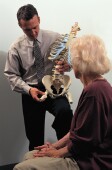
TUESDAY, May 14 (HealthDay News) — A new combination drug therapy for osteoporosis appears to increase bone density more effectively than any treatment now on the market, according to the results of a small clinical trial.
Researchers found that postmenopausal women experienced significant amounts of bone growth by taking a bone-building drug called teriparatide with denosumab, a targeted therapy drug used to stop bone loss.
“A combination of these two medications increased bone density more than either does on its own, and it is more effective than any currently approved therapy,” said study author Dr. Benjamin Leder, who is with the endocrine unit at Massachusetts General Hospital in Boston.
The 12-month study, published online May 15 in The Lancet, was funded in part by the drugs’ makers, Eli Lilly and Amgen. It involved 94 postmenopausal women being treated for osteoporosis, a bone-thinning disorder common in old age that makes bones more likely to break.
Researchers divided the group into thirds, with one third receiving a combination therapy of teriparatide (Forteo) and denosumab (Prolia), and the rest taking one medication or the other.
Those treated with both drugs enjoyed significantly better results than those receiving just one. For example, bone density measured at the lumbar spine increased 6.2 percent with teriparatide alone and 5.5 percent with denosumab alone, but combination treatment resulted in a 9.1 percent increase. Bone density at the hip increased 4.9 percent with the combination treatment versus 2.5 percent with denosumab and 0.7 percent with teriparatide.
Bones are in constant flux, with one set of cells forming new bone while other cells break down bone through a process called resorption. After women go through menopause, resorption begins to outpace the formation of new bone, leading to bone thinning and an increased risk of fractures.
Several types of drugs are approved to tackle the problem. Medications such as teriparatide stimulate new bone growth, and drugs such as denosumab reduce bone resorption, but none do both at the same time.
The combination used in this study works because the two drugs act in concert to overcome each other’s shortcomings, Leder said.
“Whereas teriparatide increases bone formation, it also increases bone resorption,” Leder said. “Denosumab completely blocks the ability of teriparatide to increase bone resorption, but does not block its ability to increase bone formation.”
Dr. Felicia Cosman, senior clinical director for the National Osteoporosis Foundation, said the findings look very promising.
“I think it is time to reconsider the whole issue of combination therapy, based on this study and others, particularly for people with extremely high fracture risk,” Cosman said.
However, she noted that it remains to be seen whether the effectiveness of the combination therapy will hold up beyond the first year, a concern shared by Dr. Richard Bockman, chief of endocrinology at Hospital for Special Surgery in New York City.
“This is an interim report, and the data are what they are. I think you have to see the two-year data,” Bockman said. “You don’t see the full benefit with regards to bone benefit at the hip in the first 12 months. You do see the change at the spine.”
And another expert pointed out another possible caveat.
There’s some question about whether the new bone grown with this therapy will be better able to resist fractures, said Dr. Joseph Lane, chief of metabolic bone disease service at Hospital for Special Surgery and a professor of orthopedic surgery at Weill Cornell Medical College in New York City.
“It seems to work,” Lane said. “This is an important step in the right direction. It proves you can make more bone.”
But Lane wonders about the quality of that bone. Only data on fracture healing can address that question, he noted.
The study authors acknowledged that additional research is needed before the combination treatment should be used in clinical practice.
Leder noted that both drugs are expensive, which makes the therapy potentially most cost-effective for patients in dire need.
“Because we don’t know what the effect is on fractures, it’s a hard calculation to make,” he said. “If it prevents x number of fractures, then it could be cost- effective.”
More information
The National Osteoporosis Foundation has more about prevention and treatment.

